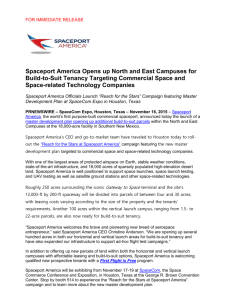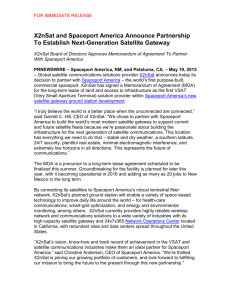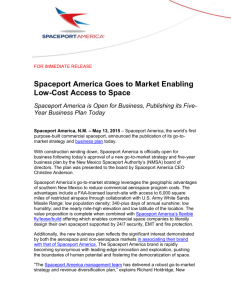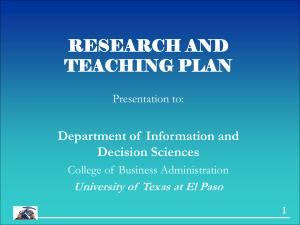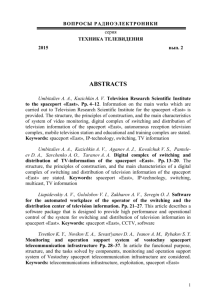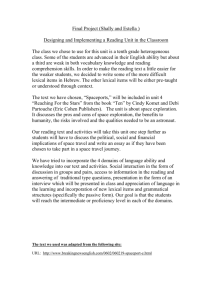FEB The Commercial Spaceport 18201 ARCHIVES
advertisement
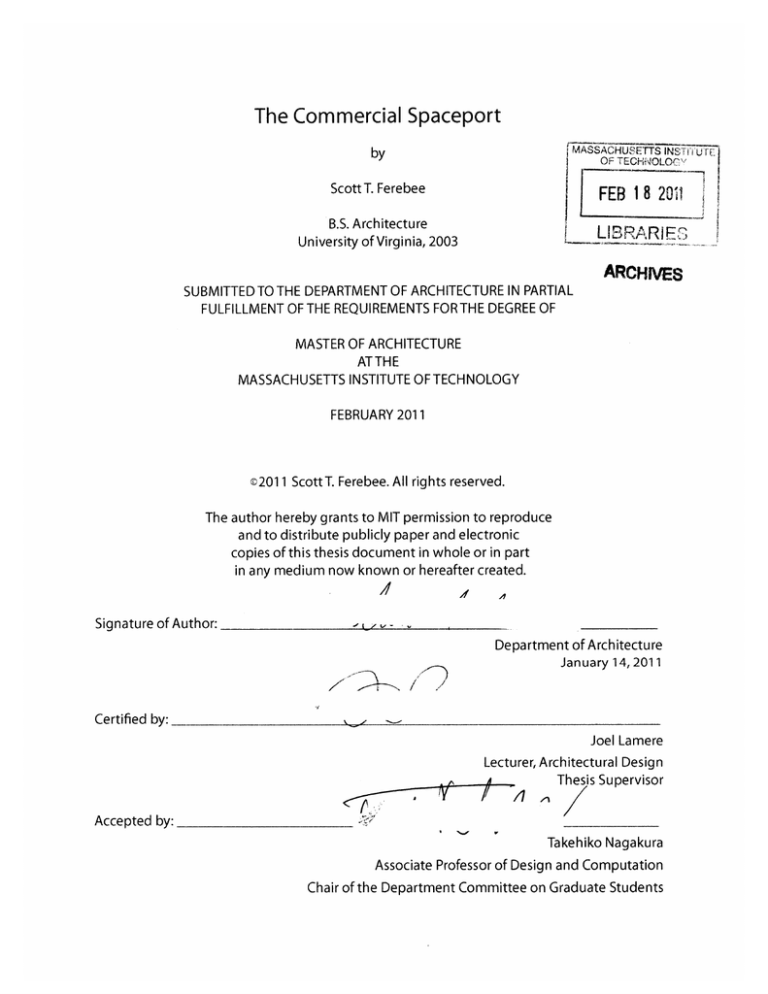
The Commercial Spaceport by Asi NSiiTUrT OF TECHNO-11LOGY% ScottT. Ferebee FEB 18201 B.S. Architecture University of Virginia, 2003 LIBRA RIES ARCHIVES SUBMITTED TO THE DEPARTMENT OF ARCHITECTURE IN PARTIAL FULFILLMENT OF THE REQUIREMENTS FOR THE DEGREE OF MASTER OF ARCHITECTURE ATTHE MASSACHUSETTS INSTITUTE OF TECHNOLOGY FEBRUARY 2011 c2011 Scott T.Ferebee. All rights reserved. The author hereby grants to MIT permission to reproduce and to distribute publicly paper and electronic copies of this thesis document in whole or in part in any medium now known or hereafter created. Signature of Author: --------- Department of Architecture January 14, 2011 7- / Certified by: Joel Lamere Lecturer, Architectural Design 10 1 Thesis Supervisor Accepted by: Takehiko Nagakura Associate Professor of Design and Computation Chair of the Department Committee on Graduate Students The Commercial Spaceport by Scott T. Ferebee B.S. Architecture University of Virginia, 2003 Thesis Committee Joel Lamere, MArch Lecturer, Architectural Design Nick Gelpi, MArch Lecturer, Architectural Design Mark Jarzombek, DiplArch, PhD Professor of the History and Theory of Architecture Associate Dean, School of Architecture and Planning The Commercial Spaceport by Scott T.Ferebee B.S. Architecture University of Virginia, 2003 Submitted to the Department of Architecture on January 14, 2011 in Partial Fulfillment of the Requirements for the Degree of Master of Science in Architecture ABSTRACT Space tourism is poised for dramatic growth in the coming decades, as an industry once considered the exclusive purview of the military-science elite ramps up to serve the interests of mass commerce. The cost to private citizens for a trip to space today isover twenty million dollars, which buys an extra seat on a ten-day maintenance mission to the International Space Station. The cost to private citizens in 2040 will be twenty thousand dollars, enough to purchase a seat on a purpose-built spaceplane and spend two weeks in an orbiting hotel. In this context, the commercial spaceport represents a new transportation typology. It must respond to the new technical demands of space travel, as well as acknowledge its cultural import as a gateway for millions of people to the last and greatest of frontiers. Here, the stakes are raised: not only isthe commercial spaceport responsible for the education, training, and rehabilitation of passengers, but also for'wowing'them. Here, everyone gets their money's worth. The site is Las Vegas, that most renown of frontier artifices. From the nuclear weapons explosions visible for decades from the strip to the ethos of excess that subverts the diurnal cycle, Las Vegas has always been atesting ground. As a threshold to the fringe, the spaceport is a natural extension of this narrative. Thesis advisor: Joel Lamere Lecturer, Architectural Design Acknowledgements I would like to thank the members of my thesis committee for their insight and support, and in particular I would like to thank my advisor, Joel Lamere, for his dedication and patience. I am deeply indebted to my colleagues for their most valuable and timely contributions: Cynthia Ting, Robin Willis, and Ann Woods. Thanks are also due to: Deborah Buelow, Florence Doughty, Christopher Guignon, James Graham, Sarah Hirschman, Meredith Miller, and Tim Olson. Bibliography Advisory Committee on the Future of the U.S. Space Program [Augustine Committee], "Review of the U.S. Human Space Flight Plans Committee, June 2009. "Aiming High: China ismoving heaven and Earth to put a man on the moon,"The Economist, October 22 2009. David Ashford,"Funding the Development of a Space Tourism Industry", presented at the International Symposium on Space Tourism, Bremen, Germany, March 1997. David Ashford, "How Soon Will Space Tourism Start?" Architectural Design, Vol. 70 No. 2, March 2000. David Ashford, "Space Tourism - How Soon Will It Happen?" presented at IEEE Aerospace Conference, Snowmass, Colorado, February 1997. David Ashford, Spaceflight Revolution (London: Imperial College Press, 2002). Patrick Collins, "Space Tourism Market Demand and the Transportation Infrastructure", presented at AIAA/ICAS Symposium'The Next 100 Years'in honor of the Wright Brothers'first flight. Patrick Collins, "Space Tourism - the Key to the Coming Economic Boom" Architectural Design, Vol. 70 No. 2, March 2000. Federal Aviation Administration, "2010 U.S. Commercial Space Transportation Developments and Concepts: Vehicles, Technologies, and Spaceports;'January 2010. Contents PartOne 7 Project Brief 9 The Politics of Space Exploration 13 Spaceport Program Guide PartTwo 20 Precedents 28 Las Vegas Spaceport PART ONE The 21st-century Spaceport Spaceports are coming. In a country such as the United States, where the National Aeronautics Space Administration (NASA) is poised to be supplanted in technological innovation by a burgeoning private industry, they are coming. In a country such as China, where the military-run space program is very publicly drawing up plans to land an astronaut on the moon by 2020, they are coming. Subjected for decades to stop-start long-term planning and attritional budget cuts, NASA is now about to step back from its traditional role as an all-in-one space agency. NASA will still produce its own heavy-lift launch vehicles for possible returns to the Moon or a new mission to Mars; however, with regard to the emerging space tourism industry, NASA's role will be largely one of official oversight over a growing number of grass-roots private enterprises ready to develop their own proprietary space vehicles.1 No such fickle politics have slowed China, which in 2003 placed an astronaut into orbit with proprietary launch hardware despite being almost totally frozen out of the international space community for the duration of its space program. Already, construction is underway in what is to become "China's Kennedy Space Center," a city (Wenchang) Advisory Committee on the Future of the U.S. Space Program [Augustine Com1 mittee], "Review of the U.S. Human Space Flight Plans Committee, June 2009, 115. -1....................... ........ - I'll, - 11 11-_ _ The runway at Spaceport America, New Mexico source: Spaceport America that will also feature a space theme park and nearby resorts. 2 These are only two, albeit arguably the two to watch, of a number of nations ramping up their space commerce industries. In an increasingly globolized world, high-technology jobs are coin of the realm. The lucrative prospect of space tourism fits the bill, and surely no other industry captures the thrill of a new frontier and the menace of an unknown quantity, or is so loaded with geopolitical historical implications, as space travel. The site is Las Vegas, that most renown of frontier artifices. From the nuclear weapons explosions visible for decades from the strip to the ethos of excess that subverts the diurnal cycle, Las Vegas has always been a testing ground for technological, sociological, and recreational experimentation. It is home to the bizarre, and literally, the alien; Area 51 is only a litte more than a hundred miles away. As a threshold to the fringe, the spaceport is a natural extension of this narrative. The spectacle of space travel, be it in the human centrifuge which simulates the G-forces of takeoff and landing, the boarding of the spaceplane, or the rocket ignition of the stage 2 craft high in the sky above the city, represents a new era of hyperactivity in the de facto capital of frontiersmanship. 2 "Aiming High: China is moving heaven and Earth to put a man on the moon," The Economist, October 22 2009. - W- 1Ip~ *~~' "I 110 1i *y~I I i ?) * , to Illustration from Topographia Christiana, a 6thcentury treatise that posited a flat Earth theory. The Politics of Space Exploration Long before space travel per se, space exploration was an epistemological question. In the western world, Aristarchus of Samos is credited with the inaugural proposition of a heliocentric universe. While the democratic nature of governments of ancient Greek city-states varied widely, Aristarchus was nonetheless fortunate to be born into a culture in which empirical skepticism was valued. Over a thousand years later, with the Christian Catholic church in ascendancy in Europe, such scientific curiosity was outright dangerous. The church's authority was predicated on the control of information, and on its exclusive rights of interpretation of scientific phenomena. Questions pertaining to the shape of the world and its geographic position in the firmament went straight to the heart of the Catholic church's authority. Among the things known then, God lived in the sky, the Earth was flat, and the Earth was the center of the universe. The Bible was the definitive arbiter of truth, and biblical interpretation was the exclusive purview of the Catholic clergy. This state of affairs was feasible because of widespread illiteracy. Even after the innovation of Gutenberg's movable type printing press in the latter half of the 15th century, literacy rates would remain relatively small for centuries. While perhaps unfair to the majority of educated clergy at the time, it is worth noting that the Copernicus' De revolutionibus was not stricken from the index of prohibited books until 1835. Sputnik launch, 1957 The sky may no longer be considered the literal location of God, but little else has changed in way that space exploration has remained politicized. In this century, as in any other, space exploration has been deployed in the service of imperialism. In fact, if anything, the stakes have been raised with the rate of globalization. Its gains are always measured to enhance one nation, or one religion or one ethnicity, at the expense of others. The launch of the first artificial satellite by the Soviet Union in 1957, was an occasion of public trepidation and crisis meetings among the circles of leadership in the United States. If it was received as a shot across the bow in anticipation of war, it was because the Soviet Union welcomed such an interpretation. Though war never came, the events of the so-called "space race" remains affixed to the respective reputations of both countries. In the widely accepted nationalist narrative of the United States, a concerted effort of science and industry was able to overcome an initial deficit to a sworn enemy and record a resounding victory by completing the first manned moon mission in 1969. Fifty years later, space exploration continues to be one of the most iconic metrics by which to judge national progress. China, grooming itself as the heir apparent to the United States as planetary superpower, has announced plans to send a manned mission to the moon in 2013. No matter that no manned missions to the moon have been ... .... . ..... ... .................. ....... ........... North Korea missile launch in April 2009 source: DigitalGlobe Image Library undertaken since 1975, on account of no scientific basis to make the effort worthwhile; for the Chinese, the prestige of being the second nation to send a man to the moon is worth the cost. To be the first this nation this century, and the first nation to have done it in pristine, high-definition video, and to have done so largely independently of any international cooperation, is an immense source of pride. The United States has consistently refused to share technology with the Chinese program, on account of the Chinese program's official status as a branch of the military. Now, with the United States grounding its own fleet of vehicles amid safety concerns and budget cuts, the narrative of China's space program looks set to become wrapped into a much larger one about the well-being of one superpower and the rise of the next. Indeed, amidst the controversy surrounding the weapons programs of so-called rogue nations, one of the few topics compelling enough to divert the pubIc attentions of the governments of Iran and North Korea away from the issue of nuclear weapons remains the launch of proprietary space vehicles. The two are interrelated, of course; the projects of space exploration and war-waging have been technologically linked since the launch of the Sputnik satellite on a rocket designed for a payload of a nuclear warhead. When North Korea staged what is widely believed to be another failed missile test in 2009, it did so under the guise of a satellite launch. State-controlled media declared the . .. .... ................ .... .. test pilot Brian Binnie boards SpaceShipOne for Ansari X Prize-winning flight, 2009. source: Mark Massie launch a success, and television reports within North Korea included audio playback of nationalist songs purported to be broadcast from the satellite in orbit. Into this contest now enters the industries of mass commerce. Virgin Galactic, based in New Mexico, plans to begin flights above the 100km threshold in the year 2011. Other companies are already in the advanced stages of design of either space vehicles or space habitat modules. As National boundaries no longer define the nature of the participants. As selfish as governments, yet unburdened by national narratives, private corporations are free to grow and subsume one another as markets allow. Soon, privately-funded excursions to space will be the primary means of access for the overwhelming majority of space travelers. With the exception of certain major infrastructural components (ie moon base), government intervention into space travel will be limited to specification oversight and best practice regulation. Spaceport Program Guide 1.General Conditions Space tourism demands more from its participants than any current form of commercial travel. Therefore, while similar in many respects to modern airport terminals, the Spaceport Passenger Terminal (SPT) features additional programmatic requirements. Passengers and staff must develop and teach new knowledge bases and new skill sets. These include training in take-off and reentry protocols, familiarity with the life support systems of a space suit, fluency in microgravity habitation protocols (including exercise, meal, and restroom routines), and the capacity for safe and alert conduct within any permanent space hotel or habitation facility. Also required is a rehabilitation center for those returning from extended stays in a microgravity environment. Depending on the duration of microgravity exposure, the recuperation time can last from days to weeks. Space travel carries a number of known health risks, and therefore returning tourists must be able to avail themselves of medical facilities as well as physical rehabilitation facilities. The medical facility will also include a necessary research component, where biometric data can be stored and analyzed, contributing to a safer, more enjoyable space travel experience. I. Passenger Terminal The majority of space tourists will embark on extra-orbital flights in twostage spaceplanes with horizontal take-offs and landings. Runway take-off and landing segments of spaceplane travel are very similar to modern airline travel; in fact, most standard high-traffic airport runways are long enough to accommodate spaceplanes. For this reason, space tourism may be seen as a logical extension of the commercial airline industry. As such, modern airport terminal design is a logical precedent for commercial spaceport terminal design. Spaceplane vehicles already exist, and have been demonstrated as viable and costeffective for passenger flights beyond the 100km altitude threshold. Perhaps the most well-known of these vehicles is SpaceShipOne, which won the 2009 Ansari X-prize for becoming the first reusable craft to break the 100km altitude threshold twice within a span of 14 days. Virgin Galactic subsequently acquired the rights to SpaceShipOne and has continued development of the vehicle for its New Mexico spaceport, Spaceport America. Current spaceplane vehicles, including SpaceShipOne, consist of two stages: a carrier airplane and a smaller, air-launched rocket-propelled craft. The first stage, the carrier airplane, takes off horizontally and climbs to a prescribed altitude, at which time the second stage detaches from the carrier and uses rocket propulsion to escape earth's atmosphere. Both stages subsequently land horizontally. While orbital altitudes are still not achievable with existing spaceplane vehicles, the proof of concept has been demonstrated. Orbital flights with spaceplanes using existing technology are projected to occur within 10 years. .... ............. "I'll 11 11 Conceptual design for space hotel. source: Bigelow Aerospace 11. Space Hotel The future of any space tourism network lies in the eventual realization of a permanent, orbiting place of habitation in space. Designs for so-called 'space hotels' have been underway for decades. What has been missing, until now, is for the technology of launch vehicles to become accessible and affordable enough for the private sector to consider funding the construction of such projects. Ill. Rehabilitation and Medical Research Facility Astronauts are renown for their physical and mental fitness, but the bodily demands of space flight per se are not the reason for such high fitness thresholds. Rather, it is simply a function of cost. Space flights are extremely expensive - the approximate cost of a Space Shuttle launch to service the International Space Station is $500 million - and much of this cost is invested into launch hardware that is not reusable. With so much at stake, all mission risks must be minimized, including those relating to the health and competency of the crew. As of May 2010, 517 individuals had traveled beyond the altitude of 100km, the internationally-recognized boundary of the earth's atmosphere. While the health effects of space travel on these individuals are well-documented, this number is only a small sample size of a relatively small fitness demographic. The health effects of space travel on humans in anything less than peak physical condition are still largely unstudied. As such, the burgeoning space tourism industry requires a necessary medical research program to study the effects of space travel and develop health protocols to educate tourists and treat symptoms of microgravity habitation. Many of the known deleterious health effects experienced in microgravity appear as forms of accelerated aging. These include bone loss, muscle atrophy, reduced cardiovascular performance, and impairment of the neurovestibular system . Muscle atrophy and loss of bone mass can begin by the tenth day spent in a zero gravity environment. Bone loss occurs at a rate of approximately 1 to 1.5% per month, the effects of which are similar to osteoporosis. When muscles lose mass, they and their connective tissues become more susceptible to injury and fatigue. All muscles will atrophy to some extent in microgravity, but of particular note are the muscles in the lower extremities, so used to resisting gravity, and the heart, which uses less force to pump blood throughout the circulatory system. In addition to muscle atrophy in the lower extremities, bodily fluids in general become redistributed away from the extremities to the torso and head. The neurovestibular system is the network of sensory, motor, and brain functions that Ill. Rehabilitation and Medical Research Facility (cont.) governs balance, vision, and the understanding of bodily orientation in space. Micogravity habitation has been demonstrated to impair this system's performance and cause disorientation and the loss of muscular coordination. The health effects of space travel are not entirely undesirable. Due to reduced bodily exertion in microgravity environments, many astronauts report feeling rested after only three to four hours of sleep per night. Of course, these effects require further study; while they may be perceived as an improvement in the short-term, prolonged periods of reduced sleep among tourists require more research and observation. Fortunately, these effects are reversible. Upon returning to Earth, space tourists are encouraged and sometimes required to spend time rehabilitating their bodies to reacclimate to Earth's gravity. Along with physical rehabilitation of bones and muscles, returning space tourists should receive healthy amounts of natural sunlight. Hyperbaric chambers can also speed the recovery process, as they have been noted for their healing effects and success in combating symptoms of aging, which are similar to the effects displayed by the human body after significant time spent in zero gravity. 18 PART TWO LAS VEGAS SPACEPORT ............ ... .... .. ..... Precedent: Pleasure Garden The precedent for translating escapist, even utopic, aspirations into form is the pleasure garden of premodern European aristocracy. A theme park must establish a clear boundary between what lies within and what lies without. Within its walls, behavioral norms and the exigencies of daily life disappear; nature is to be controlled, even manipulated to a degree of unreality. Witness the sculpted, sometimes maze-like forms of hedges, and the mastery of gravity itself in the form of fountains. Mountains rise out of earth or simulated materials. Traditional notions of scale are warped. The physical size and mass of objects may vary according to intended effect (replica mountains, boats, cars, and buildings). Time also becomes variable, as the notional present is displaced by projections of the past and future. .. ... ... ... ... ... ... ... ... ... ... .. .... . ... . .. Precedent ..................................................................... .............................. Amusement Park The prototypes of kinesthetic diversion are found in the original amusement parks of Coney Island. Constructed and popularized around the turn of the twentieth century, these parks became sites of social and industrial experimentation. The rides themselves represented a new kind of entertainment spectacle, one in which physical forces could be harnessed and unleashed as a wholly original, collective experience. ....... .................. .... .... .................. :::::::..::.:.:.: . ..... ........... ..... .. ...................... ..................................... .... ........... Precedent. World's Fair The educational aspect of the theme park is presaged in the tradition of the World's Fair trade exposition. The most iconic examples evince a technological fetish: Paxton's Crystal Palace, which housed the inaugural World's Fair in 1851; the Eiffel Tower, built for the 1889 Fair in Paris; the generator farms that powered the 1893 Fair in Chicago; the geodesic dome that would appear at multiple expositions during the twentieth century. As part of the exhibitions, these structures and machines were meant to be informative. As symbols of technical progress, they conveyed optimism in an industrialized future. No less branded and commodified than the wares they served, these were symbols of commerice as well, elevated to the status of cultural iconography. ........... S O - Just as electric generators were objects S of wonder ...... .... ............................................................... ... .. :i at the Co- lumbian Exposition, so too shall the spaceplane inspire awe. ... ................ .......... Precedent: Theme Park The prototype of the modern theme park, Disneyworld combines elements of the Pleasure Garden, Amusement Park, and World's Fair. It establishes a formal logic on what lies within its boundary, provides the thrill of moving rides and exposure to the elements, and celebrates the potential to innovate our artificial environments. The Theme Park is collection of nested worlds, each one uniquely themed geographically, culturally, and temporally. Theme Parks collapse time - one are may be set up to celebrate the past, while an adjacent area celebrates the future. Each nested world features its own internal logic with regard to circulation, framed views, and delineation between public and private spaces. The theme park is pure artifice; on a vacant slab of land framed by highways, Walt Disney planted forests and carved out riverbeds. 26 Nested Worlds Disneyland is organized into two levels of nested worlds: 1) Disneyworld, hotels and parking lots separated from site, and 2) Disneyworld itself partitioned into (4) distinct zones. 1Adventureland 2Frontierland 3 Fantasyland 4Tomorrowland | Er--I [r7 | .......... The object of our dreams, filled with our junk As of 2009, approximately 19,000 man-made objects larger than 10Ocm orbit the Earth. Most of these objects exist in Low Earth Orbit (LEO). This number is set to increase exponentially as the commercial space tourism industry ramps up and collisions between objects produce more even more debris. Debris image source: NASA Orbital Degree Program Office 28 sasa .x x x x x............ x xx. . . . ...:::::::.. ............ :::::. .. . dd x xx xx x ada a xx x x . . .............. 29 :.. . . ada aad ada x xx x x xx x . . . . ............ . ..... ......... .. .... .......... ::::............ 13 12 2 10 Existing Spaceports Federal Spaceport *Private Spaceport 1 California Spaceport 2 Vandenberg Air Force Base (AFB) 3 Mojave Air and Space Port 4 Edw/ards AFB 5 Las Vegas Spaceport (proposed) 6 Spaceport America 7 White Sands Missile Range 8 Oklahoma Spaceport 9 Space Florida Spaceport 10 Cape Canaveral Air Force Station 11 Cecil Field Spaceport 12 Mid-Atlantic Regional Spaceport 13 WNallops Flight Facility ............................ - -- I ........ ..... SURGEON GENERAL'S WARNING Prolonged exposure to microgravity causes bone and muscle loss Bone loss occurs at a rate of up to 1.5% per month and begins after one week. Do not fly if you have a heart condition. Women who are pregnant should avoid space travel. Consult your doctor to determine if you are healthy enough to experience microgravity. 35 .............................. 36 ............ ::=:::..:::: . ...... - .-:-:--:-:--:-:--:-:--:-:--:-:--:-:--xxxxxxxxxx xxx:-:-::-:-::-:-:--:-:--:-:-:-::-:-::-:-::-:-::-xxxxxxxx-:-:--:-:--:-:--:-:----:-::-:-::-:-:----::-:-::-:-::-:-:--:-::-:-:--:-::-:-::-xxxxxxx. i$ *~ ... .. . xxxxxxxx....... xxxx .:::::................. ... .:::: .:..::..::..::..::. x: ............. 10 .......... teso:...:..:..:...::......::..::. -xxxxxx:..:.xxxxxx..ei ......... x..xx..................................... /1 7 t7 A i ......................................................................... ........... 45 OF I SPACE TOURISM Human centrifuge as roulette wheel viewed from satellites 2 Stage 2 rocket ignition in sky (airlaunch from carriercraft) 0 Aquarium (for suit testing) viewable from the strip and hotel 4 Boardingprocess visible from cars on the strip 5 Boardingprocess visible from bleachers and hotel 47 East - West Section Perspective (NTS) 48 ----- xxxxxx . ... . . .. . . .. . . . . ........ View from the strip 52 ................. .............. . ... ...... sidewalk entrance to human centrifuge ... ................ ................... ...... ...... ..... view of courtyard from hotel ................ - .. ............................................................................................................... . ... .... .................. 10:46:15 :mMS eye AL T::017 Las VegasSpcor Longitute 151 N EXT SPIN: 15 min 12 sec WIN AN ALL-EXPENSES PAID TRIP TO SPACE! TODAY'S WINNING NUMBERS: PREVIOL S WINNING NUMBERS: 41-91-14-30 centrifuge roulette played from space hotel 97-27 ........... ........... --.. ............ .. .. .. ... .. .. ...... ..................................... ... ...... ...... ........ .. .. .. .. .. .. ...... .. . -b gml=b ............... view from exhibition hall floor at stage 2 air launch 60 63 .............................. ............................... .... ........ ................... ::- 66 .... . ....... ..... . ......... ............ ..... ............. -I .............. ........................................................ 1 1. 1........... . .... ........ .... ...... ...... ... .. ... ... .... .... ..... 69 C x..::...::..::...::..::...::..::...::..:::.. x................................................................................................................................... . ............... ........... ....................... ...................... . ................... 33333333333333333 s3333::--:-...............................-:-33333as3333333333333333 1111111111111111........... .33333
